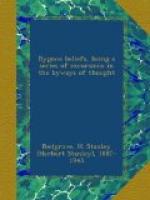The question naturally arises, What were the results obtained by these magical arts? How far, if at all, was the magician rewarded by the attainment of his desires? We have asked a similar question regarding the belief in talismans, and the reply which we there gained undoubtedly applies in the present case as well. Modern psychical research, as I have already pointed out, is supplying us with further evidence for the survival of human personality after bodily death than the innate conviction humanity in general seems to have in this belief, and the many reasons which idealistic philosophy advances in favour of it. The question of the reality of the phenomenon of “materialisation,” that is, the bodily appearance of a discarnate spirit, such as is vouched for by spiritists, and which is what, it appears, was aimed at in necromancy (though why the discarnate should be better informed as to the future than the incarnate, I cannot suppose), must be regarded as sub judice.[1] Many cases of fraud in connection with the alleged production of this phenomenon have been detected in recent times; but, inasmuch as the last word has not yet been said on the subject, we must allow the possibility that necromancy in the past may have been sometimes successful. But as to the existence of the angels and devils of magical belief—as well, one might add, of those of orthodox faith,—nothing can be adduced in evidence of this either from the results of psychical research or on a priori grounds.
[1] The late Sir WILLIAM CROOKES’ Experimental Researches in the Phenomena of Spiritualism contains evidence in favour of the reality of this phenomenon very difficult to gainsay.
Pseudo-DIONYSIUS classified the angels into three hierarchies, each subdivided into three orders, as under:—
First Hierarchy.—Seraphim, Cherubim, and Thrones;
Second Hierarchy.—Dominions, Powers, and Authorities (or Virtues);
Third Hierarchy.—Principalities, Archangels, and Angels,—
and this classification was adopted by AGRIPPA and others. Pseudo-DIONYSIUS explains the names of these orders as follows: " . . . the holy designation of the Seraphim denotes either that they are kindling or burning; and that of the Cherubim, a fulness of knowledge or stream of wisdom.... The appellation of the most exalted and pre-eminent Thrones denotes their manifest exaltation above every grovelling inferiority, and their super-mundane tendency towards higher things; . . . and their invariable and firmly-fixed settlement around the veritable Highest, with the whole force of their powers.... The explanatory name of the Holy Lordships [Dominions] denotes a certain unslavish elevation . . . superior to every kind of cringing slavery, indomitable to every subserviency, and elevated above every dissimularity, ever aspiring to the true Lordship and source of Lordship.... The appellation




